Kurt Partridge
LLM-Synth4KWS: Scalable Automatic Generation and Synthesis of Confusable Data for Custom Keyword Spotting
May 29, 2025Abstract:Custom keyword spotting (KWS) allows detecting user-defined spoken keywords from streaming audio. This is achieved by comparing the embeddings from voice enrollments and input audio. State-of-the-art custom KWS models are typically trained contrastively using utterances whose keywords are randomly sampled from training dataset. These KWS models often struggle with confusing keywords, such as "blue" versus "glue". This paper introduces an effective way to augment the training with confusable utterances where keywords are generated and grouped from large language models (LLMs), and speech signals are synthesized with diverse speaking styles from text-to-speech (TTS) engines. To better measure user experience on confusable KWS, we define a new northstar metric using the average area under DET curve from confusable groups (c-AUC). Featuring high scalability and zero labor cost, the proposed method improves AUC by 3.7% and c-AUC by 11.3% on the Speech Commands testing set.
GraphemeAug: A Systematic Approach to Synthesized Hard Negative Keyword Spotting Examples
May 20, 2025Abstract:Spoken Keyword Spotting (KWS) is the task of distinguishing between the presence and absence of a keyword in audio. The accuracy of a KWS model hinges on its ability to correctly classify examples close to the keyword and non-keyword boundary. These boundary examples are often scarce in training data, limiting model performance. In this paper, we propose a method to systematically generate adversarial examples close to the decision boundary by making insertion/deletion/substitution edits on the keyword's graphemes. We evaluate this technique on held-out data for a popular keyword and show that the technique improves AUC on a dataset of synthetic hard negatives by 61% while maintaining quality on positives and ambient negative audio data.
GE2E-KWS: Generalized End-to-End Training and Evaluation for Zero-shot Keyword Spotting
Oct 22, 2024Abstract:We propose GE2E-KWS -- a generalized end-to-end training and evaluation framework for customized keyword spotting. Specifically, enrollment utterances are separated and grouped by keywords from the training batch and their embedding centroids are compared to all other test utterance embeddings to compute the loss. This simulates runtime enrollment and verification stages, and improves convergence stability and training speed by optimizing matrix operations compared to SOTA triplet loss approaches. To benchmark different models reliably, we propose an evaluation process that mimics the production environment and compute metrics that directly measure keyword matching accuracy. Trained with GE2E loss, our 419KB quantized conformer model beats a 7.5GB ASR encoder by 23.6% relative AUC, and beats a same size triplet loss model by 60.7% AUC. Our KWS models are natively streamable with low memory footprints, and designed to continuously run on-device with no retraining needed for new keywords (zero-shot).
Adversarial training of Keyword Spotting to Minimize TTS Data Overfitting
Aug 20, 2024



Abstract:The keyword spotting (KWS) problem requires large amounts of real speech training data to achieve high accuracy across diverse populations. Utilizing large amounts of text-to-speech (TTS) synthesized data can reduce the cost and time associated with KWS development. However, TTS data may contain artifacts not present in real speech, which the KWS model can exploit (overfit), leading to degraded accuracy on real speech. To address this issue, we propose applying an adversarial training method to prevent the KWS model from learning TTS-specific features when trained on large amounts of TTS data. Experimental results demonstrate that KWS model accuracy on real speech data can be improved by up to 12% when adversarial loss is used in addition to the original KWS loss. Surprisingly, we also observed that the adversarial setup improves accuracy by up to 8%, even when trained solely on TTS and real negative speech data, without any real positive examples.
Utilizing TTS Synthesized Data for Efficient Development of Keyword Spotting Model
Jul 26, 2024Abstract:This paper explores the use of TTS synthesized training data for KWS (keyword spotting) task while minimizing development cost and time. Keyword spotting models require a huge amount of training data to be accurate, and obtaining such training data can be costly. In the current state of the art, TTS models can generate large amounts of natural-sounding data, which can help reducing cost and time for KWS model development. Still, TTS generated data can be lacking diversity compared to real data. To pursue maximizing KWS model accuracy under the constraint of limited resources and current TTS capability, we explored various strategies to mix TTS data and real human speech data, with a focus on minimizing real data use and maximizing diversity of TTS output. Our experimental results indicate that relatively small amounts of real audio data with speaker diversity (100 speakers, 2k utterances) and large amounts of TTS synthesized data can achieve reasonably high accuracy (within 3x error rate of baseline), compared to the baseline (trained with 3.8M real positive utterances).
Synth4Kws: Synthesized Speech for User Defined Keyword Spotting in Low Resource Environments
Jul 23, 2024Abstract:One of the challenges in developing a high quality custom keyword spotting (KWS) model is the lengthy and expensive process of collecting training data covering a wide range of languages, phrases and speaking styles. We introduce Synth4Kws - a framework to leverage Text to Speech (TTS) synthesized data for custom KWS in different resource settings. With no real data, we found increasing TTS phrase diversity and utterance sampling monotonically improves model performance, as evaluated by EER and AUC metrics over 11k utterances of the speech command dataset. In low resource settings, with 50k real utterances as a baseline, we found using optimal amounts of TTS data can improve EER by 30.1% and AUC by 46.7%. Furthermore, we mix TTS data with varying amounts of real data and interpolate the real data needed to achieve various quality targets. Our experiments are based on English and single word utterances but the findings generalize to i18n languages and other keyword types.
Mixed Federated Learning: Joint Decentralized and Centralized Learning
May 26, 2022


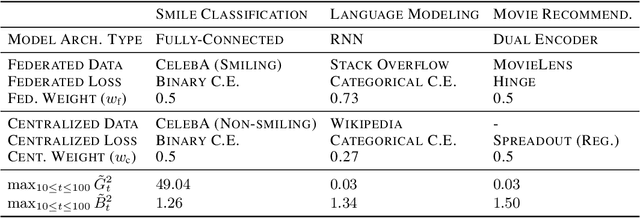
Abstract:Federated learning (FL) enables learning from decentralized privacy-sensitive data, with computations on raw data confined to take place at edge clients. This paper introduces mixed FL, which incorporates an additional loss term calculated at the coordinating server (while maintaining FL's private data restrictions). There are numerous benefits. For example, additional datacenter data can be leveraged to jointly learn from centralized (datacenter) and decentralized (federated) training data and better match an expected inference data distribution. Mixed FL also enables offloading some intensive computations (e.g., embedding regularization) to the server, greatly reducing communication and client computation load. For these and other mixed FL use cases, we present three algorithms: PARALLEL TRAINING, 1-WAY GRADIENT TRANSFER, and 2-WAY GRADIENT TRANSFER. We state convergence bounds for each, and give intuition on which are suited to particular mixed FL problems. Finally we perform extensive experiments on three tasks, demonstrating that mixed FL can blend training data to achieve an oracle's accuracy on an inference distribution, and can reduce communication and computation overhead by over 90%. Our experiments confirm theoretical predictions of how algorithms perform under different mixed FL problem settings.
Production federated keyword spotting via distillation, filtering, and joint federated-centralized training
Apr 11, 2022
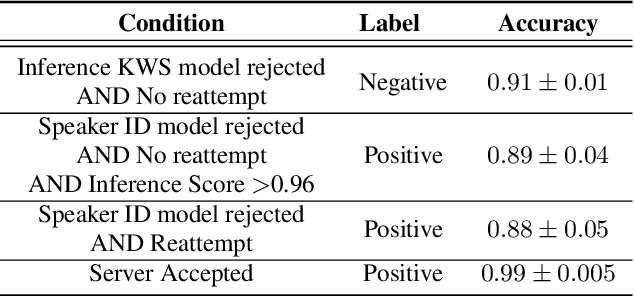
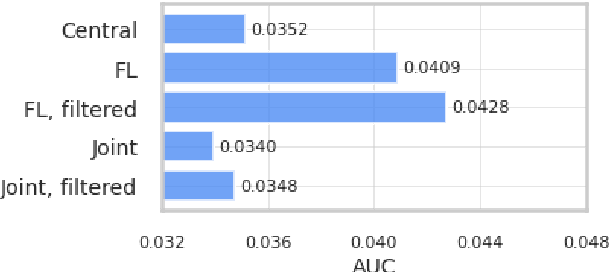

Abstract:We trained a keyword spotting model using federated learning on real user devices and observed significant improvements when the model was deployed for inference on phones. To compensate for data domains that are missing from on-device training caches, we employed joint federated-centralized training. And to learn in the absence of curated labels on-device, we formulated a confidence filtering strategy based on user-feedback signals for federated distillation. These techniques created models that significantly improved quality metrics in offline evaluations and user-experience metrics in live A/B experiments.
Jointly Learning from Decentralized (Federated) and Centralized Data to Mitigate Distribution Shift
Nov 23, 2021
Abstract:With privacy as a motivation, Federated Learning (FL) is an increasingly used paradigm where learning takes place collectively on edge devices, each with a cache of user-generated training examples that remain resident on the local device. These on-device training examples are gathered in situ during the course of users' interactions with their devices, and thus are highly reflective of at least part of the inference data distribution. Yet a distribution shift may still exist; the on-device training examples may lack for some data inputs expected to be encountered at inference time. This paper proposes a way to mitigate this shift: selective usage of datacenter data, mixed in with FL. By mixing decentralized (federated) and centralized (datacenter) data, we can form an effective training data distribution that better matches the inference data distribution, resulting in more useful models while still meeting the private training data access constraints imposed by FL.
Training Keyword Spotting Models on Non-IID Data with Federated Learning
Jun 04, 2020
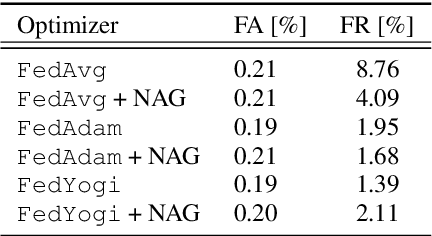

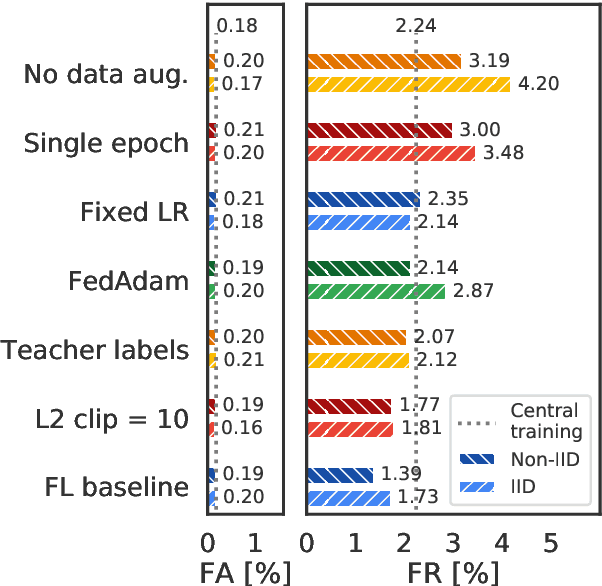
Abstract:We demonstrate that a production-quality keyword-spotting model can be trained on-device using federated learning and achieve comparable false accept and false reject rates to a centrally-trained model. To overcome the algorithmic constraints associated with fitting on-device data (which are inherently non-independent and identically distributed), we conduct thorough empirical studies of optimization algorithms and hyperparameter configurations using large-scale federated simulations. To overcome resource constraints, we replace memory intensive MTR data augmentation with SpecAugment, which reduces the false reject rate by 56%. Finally, to label examples (given the zero visibility into on-device data), we explore teacher-student training.
 Add to Chrome
Add to Chrome Add to Firefox
Add to Firefox Add to Edge
Add to Edge